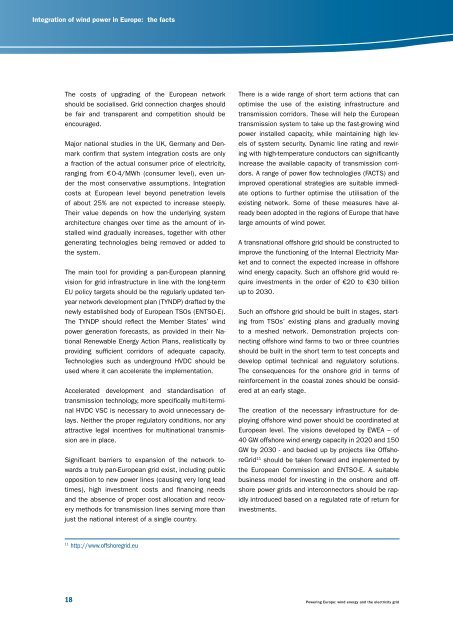Powering Europe - European Wind Energy Association
Powering Europe - European Wind Energy Association
Powering Europe - European Wind Energy Association
You also want an ePaper? Increase the reach of your titles
YUMPU automatically turns print PDFs into web optimized ePapers that Google loves.
Integrationofwindpowerineurope:thefacts<br />
The costs of upgrading of the <strong>Europe</strong>an network<br />
should be socialised. Grid connection charges should<br />
be fair and transparent and competition should be<br />
encouraged.<br />
Major national studies in the UK, Germany and Denmark<br />
confirm that system integration costs are only<br />
a fraction of the actual consumer price of electricity,<br />
ranging from € 0-4/MWh (consumer level), even under<br />
the most conservative assumptions. Integration<br />
costs at <strong>Europe</strong>an level beyond penetration levels<br />
of about 25% are not expected to increase steeply.<br />
Their value depends on how the underlying system<br />
architecture changes over time as the amount of installed<br />
wind gradually increases, together with other<br />
generating technologies being removed or added to<br />
the system.<br />
The main tool for providing a pan-<strong>Europe</strong>an planning<br />
vision for grid infrastructure in line with the long-term<br />
EU policy targets should be the regularly updated tenyear<br />
network development plan (TYNDP) drafted by the<br />
newly established body of <strong>Europe</strong>an TSOs (ENTSO-E).<br />
The TYNDP should reflect the Member States’ wind<br />
power generation forecasts, as provided in their National<br />
Renewable <strong>Energy</strong> Action Plans, realistically by<br />
providing sufficient corridors of adequate capacity.<br />
Technologies such as underground HVDC should be<br />
used where it can accelerate the implementation.<br />
Accelerated development and standardisation of<br />
transmission technology, more specifically multi-terminal<br />
HVDC VSC is necessary to avoid unnecessary delays.<br />
Neither the proper regulatory conditions, nor any<br />
attractive legal incentives for multinational transmission<br />
are in place.<br />
Significant barriers to expansion of the network towards<br />
a truly pan-<strong>Europe</strong>an grid exist, including public<br />
opposition to new power lines (causing very long lead<br />
times), high investment costs and financing needs<br />
and the absence of proper cost allocation and recovery<br />
methods for transmission lines serving more than<br />
just the national interest of a single country.<br />
11 http://www.offshoregrid.eu<br />
18<br />
There is a wide range of short term actions that can<br />
optimise the use of the existing infrastructure and<br />
transmission corridors. These will help the <strong>Europe</strong>an<br />
transmission system to take up the fast-growing wind<br />
power installed capacity, while maintaining high levels<br />
of system security. Dynamic line rating and rewiring<br />
with high-temperature conductors can significantly<br />
increase the available capacity of transmission corridors.<br />
A range of power flow technologies (FACTS) and<br />
improved operational strategies are suitable immediate<br />
options to further optimise the utilisation of the<br />
existing network. Some of these measures have already<br />
been adopted in the regions of <strong>Europe</strong> that have<br />
large amounts of wind power.<br />
A transnational offshore grid should be constructed to<br />
improve the functioning of the Internal Electricity Market<br />
and to connect the expected increase in offshore<br />
wind energy capacity. Such an offshore grid would require<br />
investments in the order of €20 to €30 billion<br />
up to 2030.<br />
Such an offshore grid should be built in stages, starting<br />
from TSOs’ existing plans and gradually moving<br />
to a meshed network. Demonstration projects connecting<br />
offshore wind farms to two or three countries<br />
should be built in the short term to test concepts and<br />
develop optimal technical and regulatory solutions.<br />
The consequences for the onshore grid in terms of<br />
reinforcement in the coastal zones should be considered<br />
at an early stage.<br />
The creation of the necessary infrastructure for deploying<br />
offshore wind power should be coordinated at<br />
<strong>Europe</strong>an level. The visions developed by EWEA – of<br />
40 GW offshore wind energy capacity in 2020 and 150<br />
GW by 2030 - and backed up by projects like OffshoreGrid<br />
11 should be taken forward and implemented by<br />
the <strong>Europe</strong>an Commission and ENTSO-E. A suitable<br />
business model for investing in the onshore and offshore<br />
power grids and interconnectors should be rapidly<br />
introduced based on a regulated rate of return for<br />
investments.<br />
<strong>Powering</strong> <strong>Europe</strong>: wind energy and the electricity grid

















